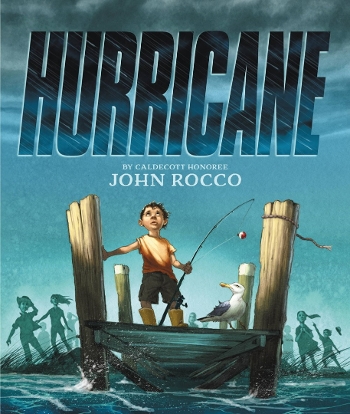John Rocco's Hurricane is a depiction of a childhood experience, authentically portrayed, and executed with thought, care, and expertise.
 Hurricane, based on John Rocco's childhood experience, is a companion to his picture books Blackout (a Caldecott Honor book) and Blizzard. The dramatic title Hurricane fits with the previous titles, but the book just as easily could have been called Dock. The micro setting of a dock and the macro setting of a neighborhood near a quiet river are practically characters in themselves.
Hurricane, based on John Rocco's childhood experience, is a companion to his picture books Blackout (a Caldecott Honor book) and Blizzard. The dramatic title Hurricane fits with the previous titles, but the book just as easily could have been called Dock. The micro setting of a dock and the macro setting of a neighborhood near a quiet river are practically characters in themselves.
(Rocco, by the way, somehow makes the setting specific yet at the same time universal. In her Horn Book review, Betty Carter speculated that the the book was set in the Southeast wetlands, perhaps Louisiana; I was sure it was the Chesapeake Bay region. We were both wrong, since Rocco grew up in Rhode Island.)
But let's return to that dock. An "old and splintery" dock jutting out into a river is the child protagonist's favorite place in the world. From it he fishes, crabs, swims, observes; he essentially indulges in all the pleasures of being around the water. The dock doesn't belong to him — it's a neighborhood dock — but it might as well be his, because no one else ever uses it. Then a hurricane roars through, leaving desctruction in its wake, including the dock. Already neglected and rickety, it is now almost completely destroyed, with its pilings broken and atilt and most of its planks missing. The boy is devastated. He asks for help repairing the dock but everyone is too busy, so instead the boy helps with the hurricane cleanup. He then tries to repair the dock himself, but it's too big a job. Eventually, his neighbors arrive with machinery, tools, and materials. "Together we rebuild my dock...and it becomes our dock." The final double-page spread depicts a community gathering place where people picnic, boat, fish, and swim.
On this last spread the blue water sparkles, the sun glows warmly, and clothing is in bright colors. This is a change from the muted colors in much of the rest of the book. Rocco expertly uses color to convey emotion and mood. The book opens with light colors when depicting the joy the boy takes in the dock; morphs into darker colors for the storm and its sad aftermath; and brightens with more vivid colors as the dock is rebuilt, better than ever. Rocco is also a master of composition, employing varied lines and shapes. Jagged vertical lines (of the dock's crooked pilings, for instance) convey disharmony, contrasting with calm horizontal lines (such as the horizon or the opposite shoreline) in scenes of stillness or peacefulness.
For me, the theme of the book is optimism and imagination as a way to counter adversity — and besides the setting and the boy's connection with the river and the dock, the theme is one of its strengths. Rocco does an excellent job of delineating theme through art, one of the Caldecott criteria.
For a book named Hurricane, the storm itself takes up little space in the book. Only four spreads — but look what Rocco does with them. He bookends them with optimism and imagination. The first of the four "storm' spreads is an exterior shot of the boy's house; we see the boy and his parents eating dinner through a mostly boarded-up window. The palette is mostly deep blues — it's nighttime, the storm is beginning, and the house is blue as well — but at the center of the illustration is a horizontal slat of warm yellow, from the light emanating from the kitchen. The text says: "At dinner my parents don't say much. I tell them that the best fishing comes right after a big storm." Optimism! The next two spreads show the storm raging. The fourth "storm" spread, in bright colors, depicts the boy thinking about the next day and "what might wash up underneath my dock." We see the boy lying facedown on the dock looking down into the water, through which swim a multitude of turtles, stingrays, and porpoises. Imagination!
Rocco's picture book is a depiction of a childhood experience, authentically portrayed, and executed with great thought, care, and expertise. Will the Caldecott committee dip its toes into its waters?
RELATED
ALREADY A SUBSCRIBER? LOG IN
We are currently offering this content for free. Sign up now to activate your personal profile, where you can save articles for future viewing.







Add Comment :-
Be the first reader to comment.
Comment Policy:
Comment should not be empty !!!